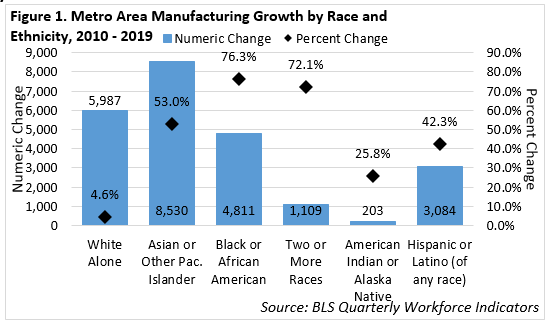 The Minneapolis-St. Paul metropolitan area is a national leader in finance, advanced manufacturing, agriculture and retailing.
The Minneapolis-St. Paul metropolitan area is a national leader in finance, advanced manufacturing, agriculture and retailing.
Medical devices, electronics and processed foods are strong suits recognized globally.
Want the freshest data delivered by email? Subscribe to our regional newsletters.
10/7/2020 9:00:00 AM
Tim O'Neill
The new face of manufacturing is much different than what most expect it to look like. Long gone are the days of manufacturing being negatively associated with the three D's: dark, dirty and dangerous. Parents who once discouraged their children from seeking a career in manufacturing are starting to sing another tune. A Brookings Institute report on The Future of Manufacturing mentioned artificial intelligence, advanced robotics and the "Internet of Things" – often referred to as "Industry 4.0" technologies – which are poised to reshape the global manufacturing landscape. These developments will have important consequences for the traditional role of manufacturing in an economy's structural transformation, growth and job creation.
What will the future of manufacturing look like in the Twin Cities metro area? What is the workforce development community doing to prepare for this change? How will changing demographics in the Twin Cities metro area affect how manufacturers recruit and retain workers? How does advanced manufacturing fit into this equation?
 Simply put, the metro area's population is becoming more racially diverse. So, too, is Manufacturing in the region. Between 2010 and 2019, Manufacturing employment in the region expanded by 13.1% (20,500 jobs). Where the number of Manufacturing jobs held by those reporting as white increased by 4.6% during that time, jobs held by Black or African Americans increased by 76.3%. Likewise, Manufacturing jobs held by those reporting as two or more races increased by 72.1%. Meanwhile, Manufacturing jobs held by those reporting as Asian or Other Pacific Islander saw the largest numeric increase between 2010 and 2019, gaining more than 8,500 jobs.
Simply put, the metro area's population is becoming more racially diverse. So, too, is Manufacturing in the region. Between 2010 and 2019, Manufacturing employment in the region expanded by 13.1% (20,500 jobs). Where the number of Manufacturing jobs held by those reporting as white increased by 4.6% during that time, jobs held by Black or African Americans increased by 76.3%. Likewise, Manufacturing jobs held by those reporting as two or more races increased by 72.1%. Meanwhile, Manufacturing jobs held by those reporting as Asian or Other Pacific Islander saw the largest numeric increase between 2010 and 2019, gaining more than 8,500 jobs.
Overall, nearly three-quarters of the 20,500 additional Manufacturing jobs in 2019 – compared to 2010 – were held by those reporting as a race other than white. Additionally, nearly one-in-six were held by those reporting Hispanic or Latino origins (see Figure 1). In 2010, about one-in-six manufacturing workers in the Twin Cities metro area reported as a race other than white. Today, that's nearly one-in-four manufacturing workers.
With changing demographics and increased diversity in manufacturing, how might recruiting and retention change? Having a strong workforce is a two-phase approach: recruiting – creating opportunities for those interested to enter the workforce – and retention – you got them, now how do you keep them? Maintaining a diverse workforce reflective of the region means introducing policies and practices beneficial to all workers.
One way employers are doing this is by tackling unconscious biases head-on. Unconscious biases are learned, deeply ingrained and universal stereotypes that influence our behaviors and judgments in ways we aren't even aware of. They're automatic and outside of conscious thought, and they can make their way into the workplace undetected. Refer to Hidden Bias in the Workplace: Retention Strategies on CareerForceMN.com for more information on strategies for retaining a diverse workforce.
With over 173,000 jobs, Manufacturing is vital to the Metro Area. In fact, Manufacturing is the region's second largest-employing industry sector and accounts for over half of the state's total Manufacturing jobs.
Advanced Manufacturing is about using innovative technology to improve products or processes. Advantages include increased project quality, decreased production times, and the opportunity for employers to be more innovative.
Manufacturing sectors are evolving with new technologies and innovations. For example, Computer and Electronic Product Manufacturing – with over 36,000 jobs in the Twin Cities area – is the Manufacturing sector with the largest employment in the region. Top-employing occupations in this sector include Electrical, Electronic, and Electromechanical Assemblers; Software Developers; Industrial Engineers; Electrical Engineers, and Mechanical Engineers.
Looking forward, the needs of advanced manufacturing will require employers to be more precise about what skill sets they want workers to have. Similarly, educators and training institutions must remain a step ahead, developing curriculum that aligns with employers' needs.

Contact Tim O'Neill, Labor Market Analyst.